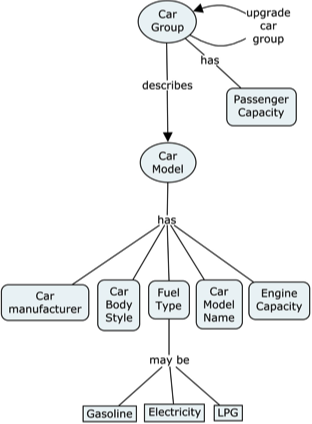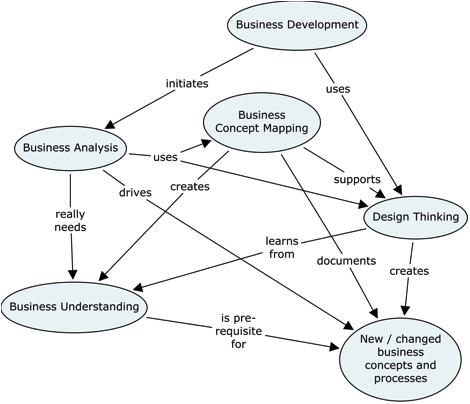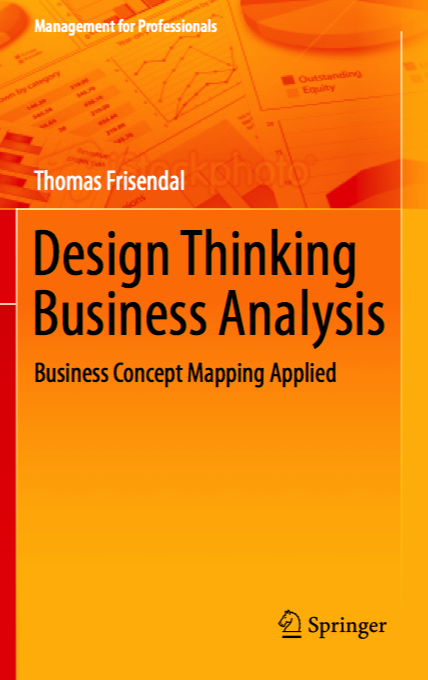Concept Maps can be used as Concept Models
A concept model is the business-level definition of a conceptual structure. From concept maps you derive concept models, which are more formal and are used as the starting point for business rules specifications (fact models).
Requirements and business solutions are two sides of the same thing, which is why business analysis is a process that deals with both aspects. That unified process is what we call information-driven business analysis.
Requirements and business solutions are two sides of the same thing, which is why business analysis is a process that deals with both aspects. That unified process is what we call information-driven business analysis.
Frisendals Law: Your business concept models are to your business information asset what your chart of accounts is to your financial assets!
Thomas Frisendal
Concept Mapping: Intuitive visual communication

The diagram to the left is a small concept map describing some detailed concepts concerning rental cars.
Concept mapping has proven to be highly successful in business analysis. Conceptual modeling (UML, Entity-Relationship diagrams etc.) failed as a business-side tool, but concept mapping - coming from educational psychology - is readily accepted in the business communities.
Contrary to common wisdom business analysis is not "just a documentation issue". It is a learning process - both for the analyst, but also for the business itself. Concept mapping works in this context because it is based on psychology (the theory of meaningful learning), rather than on an engineering mindset. Which implies that business concept mapping is a business task, as it rightfully should be.
Design Thinking: Boosting creativity
Design Thinking is a mindset that - obviously - supports creativity. Creativity is an absolutely necessary requirement of any business development effort. Concept Mapping encourages creativity, so the two techniques work together in real synergy.
Concept Modeling deals with People, Language and Meaning, not Engineering

This diagram is a concept map, which describes the top-level concepts of the book! Notice the named relationships, and notice how you can read the whole thing as sentences. Imagine the same thing expressed as a text. Clearly the concept map communicates clearer and faster.
This book from 2012 is about information-driven Business Analysis:
It guides you through the exploration, ideation and solution design on the business concept level:
Since it was published in 2012 this book has had more than 50K chapter downloads in research libraries all over the world. This makes it part of top 25% in its category!
Continue to the Graph Data Modeling page:
Or read these opinions about the Business Concept Mapping book:
The simplicity and elegance of the concept map likely enables business people to more easily envisage future states of the business in comparison to traditional data modeling, where the emphasis on formal, systematic analysis of information meaning and use can lead to too much focus on defining and carefully characterizing the past.
Dr. Barry Devlin, Founder and Principal, 9sight Consulting
"This book is a great contribution to the information management community. It combines a theoretical foundation with practical methods for dealing with important problems. This is rare and very useful. Conceptual models that communicate business reality effectively require some degree of creative imagination. As such, they combine the results of business analysis with communication design, as is extensively covered in this book.
Dr. Malcolm Chisholm, President at AskGet.com Inc
"This book addresses the timely topic of how businesses can become more effective by allowing its stakeholders to analyse their business domain better than before. The good news for the reader is that the naturality of the models used in the book today have direct applicability in software systems, which means the changes in business can be faster reflected in IT.
Dr. Janne Saarela, CEO of Profium
I enjoyed reading 'Design Thinking Business Analysis' and learned a lot about concept mapping. It is like a breath of fresh air for me having been stuck in a world described in UML and ER.
Andrew Black - Data Quality (http://en.andrewblack.eu)
Graphs are, actually, used for modeling business facing concept models in front of the design oriented solution models.
Steve Hoberman, the Data Model Rockstar, has written an excellent book about that:
The Rosedata Stone: Achieving a Common Business Language using the Business Terms Model, by Steve Hoberman, buy it using the coupon code: 'VizDataModeler' (worth 20 %), at Technics Pub.
I have developed a design thinking inspired approach, which is described here.
Steve Hoberman, the Data Model Rockstar, has written an excellent book about that:
The Rosedata Stone: Achieving a Common Business Language using the Business Terms Model, by Steve Hoberman, buy it using the coupon code: 'VizDataModeler' (worth 20 %), at Technics Pub.
I have developed a design thinking inspired approach, which is described here.

